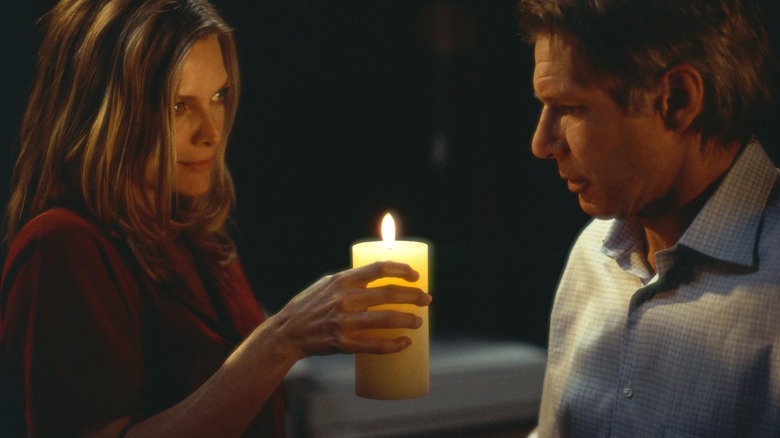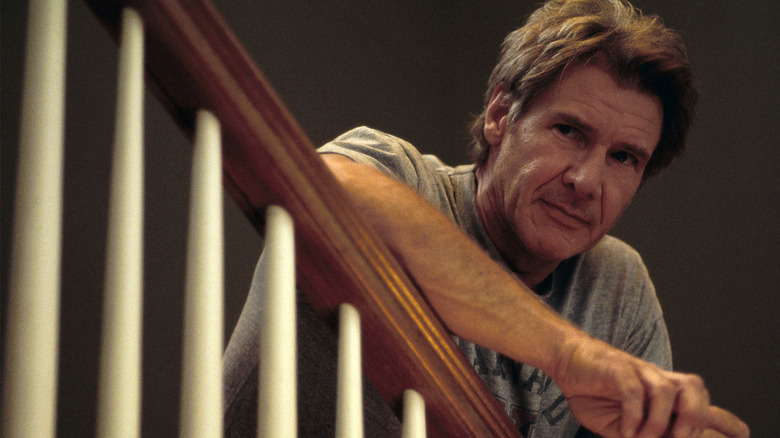Why Harrison Ford Took The Risk Of Playing A 'Villain' For What Lies Beneath
Robert Zemeckis' 2000 film "What Lies Beneath" might be the most underrated in the celebrated filmmaker's oeuvre. Written by Clark Gregg, "What Lies Beneath" came after a series of hits from Zemeckis — following 1994's awards darling "Forrest Gump" and 1997's "Contact" — and was a massive change of pace for him. Eschewing flashy sci-fi stories and effects-based splashiness, "Beneath" was a Hitchcockian thriller about suspicion, atmosphere, and a potential haunting. It was the most adult film of Zemeckis' career to date.
In the film, Michelle Pfeiffer plays Claire, a cellist who lives in an idyllic lakeside home with her professor husband Norman (Harrison Ford). Claire has overheard her immediate neighbors, another married couple, arguing violently and has even witnessed the fear on the wife's face. When she goes missing, it seems that murder might be afoot ... and that she may be haunting Claire and Norman. Indeed, Claire holds a séance, and channels the victim into her own body for a short period. Curious that the victim should think to seduce Norman.
It will eventually be revealed, through a series of recollections, as well as mysterious pieces of physical evidence, that Norman was having an affair with the victim. Norman admits to having an affair years ago, then that the victim broke into their home to take her own life, and eventually confesses to outright killing her. He also makes moves to kill Claire — he drugs her and puts her in a slowly filling bathtub — but she eventually escapes.
Infidelity Jones
Norman might be the single most villainous character Ford has ever played — just as much a change of pace for the actor as for his director. Ford has gone on record saying that he prefers to play characters that are, at least on some level, humane and sympathetic. Norman is not only cheating on his wife, but confesses to killing his mistress. This, before trying to drown his wife in a bathtub. He is a calculating and sinister figure, and one might draw parallels between Norman and Johnnie Aysgarth, the charming ne'er-do-well played by Cary Grant in Alfred Hitchcock's "Suspicion."
In a 2019 interview with Empire, Ford talked about playing Norman, and why he went so far afield from his usual code of playing sympathetic characters. He hastened to clarify that his code has nothing to do with his "image" or his public persona as a "movie star," however. Although he knows he's perceived a certain way — heroic — Ford doesn't change scripts to match a certain personality. He said:
"I don't take trouble at all to conform a screenplay to my iconography. I don't say, 'We can't do that — the audience wouldn't accept it.' I try to take the limitations of what is required to play a leading character and then screw with them."
This acting approach may be why Ford has emerged as confident as he has. He doesn't play timid or buttoned-down characters too often ("Sabrina" is an exception, as is "Regarding Henry"), but one can see, in most of his role, the actor pushing to be seen as something larger than what's on the page.
Betrayed Runner
But when asked about "What Lies Beneath," Ford admitted to wanting a change of pace, and acknowledged how audiences see him. Ford was 58 in 2000, and was still playing action heroes and romantic leads with the best of them. His most recent films had been "Air Force One," wherein he played a heroic U.S. President who violently faces off against would-be hijackers of the titular plane, and "Six Days, Seven Nights," an opposites-attract romantic adventure farce wherein he and Anne Heche fall in hate, then fall in love, while stranded on a desert island. A change of pace, it seems, was in order. "What Lies Beneath" was the opportunity.
Ford admitted as much in the Empire interview, saying:
"There comes a point when you've exhausted your opportunities playing good guys. I've been around long enough, I think I'm entitled to explore a bit. But what I saw there was an opportunity to play a character different from what the audience's expectation was. A chance to take their crude experience of me — of my iconography, if you will — and turn it on its ear at an appropriate juncture in the film to be useful to the process of telling the story."
Zemeckis filmed "What Lies Beneath" in the middle of production on his film "Cast Away," as that film's star, Tom Hanks, had to go through a lengthy physical transformation wherein he lost a great deal of weight. "Beneath" was sort of the small, "throw-off" film to keep the director occupied. That it turned out as adult-oriented and sophisticated as it did revealed how mature the filmmaker had become. It was a hit. It certainly helped that a famous screen hero hoodwinked everyone.


